No CrossRef data available.
Published online by Cambridge University Press: 25 November 2019

1. Kelly Hignett, “Video May Have Killed the Radio Star, But Did Popular Culture Kill Communism?” The View East: Central and Eastern Europe, Past and Present, last modified May 23, 2011, https://thevieweast.wordpress.com/tag/dallas/.
2. Daily Mail Reporter, “How I Brought Down Ceausescu: Larry Hagman Who Played Texas Oil Man J.R. Ewing, Claims Romania's Decision to Screen Dallas Toppled Communist Rulers,” The Daily Mail, last modified May 20, 2011, www.dailymail.co.uk/news/article-1388776/Larry-Hagman-claims-Romanias-decision-screen-Dallas-toppled-communist-rulers.html.
3. Benjamin R. Young, “What exactly is North Korea's Cultural Heritage?” NK News, last modified June 11, 2018, www.nknews.org/2018/06/what-exactly-is-north-koreas-cultural-heritage/.
4. Norimitsu Onishi, “A Rising Korean Wave: If Seoul Sells It, China Craves It,” The New York Times, last modified January 2, 2006, www.nytimes.com/2006/01/02/world/asia/02iht-korea.html; Carlos Santamaria, “Korean ‘Hallyu’ and the Pinoy Invasion,” Rappler, last modified September 19, 2012, www.rappler.com/entertainment/12681-hallyu-growing-in-ph; Christy Choi and Amy Nip, “How Korean Culture Stormed the World,” South China Morning Post, last modified November 30, 2012, www.scmp.com/news/asia/article/1094145/how-korean-culture-stormed-world.
5. Nye, Joseph S., “Soft Power,” Foreign Policy 80 (1990): 153–71CrossRefGoogle Scholar. doi:10.2307/1148580.
6. ROK Ministry of Unification, “Policy on North Korean Defectors: Data and Statistics,” Ministry of Unification, www.unikorea.go.kr/eng_unikorea/relations/statistics/defectors/, accessed May 29, 2019.
7. Cussen, John, “On the Call to Dismiss North Korean Defectors’ Memoirs and on their Dark American Alternative,” Korean Studies 40 (2016): 140–57CrossRefGoogle Scholar.